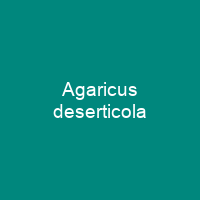Agaricus deserticola is a species of fungus in the family Agaricaceae. Found only in southwestern and western North America, it is adapted for growth in dry or semi-arid habitats. Unlike other Agaricus species, A.deserticola does not develop true gills.
About Agaricus deserticola in brief

The fungus was transferred to the genus Agaricas in 2004 after molecular analysis showed it to be closely related to species in that genus. It can reach heights of 18 cm tall with caps that are up to 7. 5 cm wide. Fruit bodies grow singly or scattered on the ground in fields, grasslands, or arid ecosystems. Other mushrooms with which A. A.desertiola might be confused include the desert fungus species Podaxis pistillaris and Montagnea arenaria. It has been known by this name for about 60 years, until a 2004 phylogenetic study revealed the species’s close evolutionary relationship with Agarici. The generic name was to honor William Henry Long, an American mycologist noted for his work in describing GasteromyCetes. In 1945, Zeller pointed out that the use of the name Longia was untenable, as it had already been used for a genus of rusts described by Hans Sydow in 1921, so he proposed the new combination Longula texensis in addition to L. texensis var. major. This resulted in a new name in the genus Longia with Longia texensis as the type species.
You want to know more about Agaricus deserticola?
This page is based on the article Agaricus deserticola published in Wikipedia (as of Oct. 29, 2020) and was automatically summarized using artificial intelligence.







